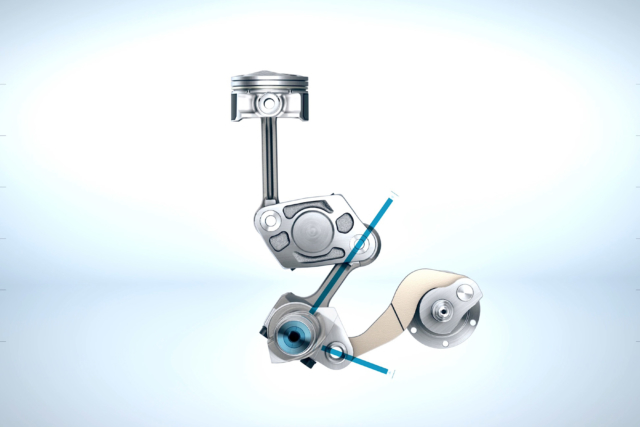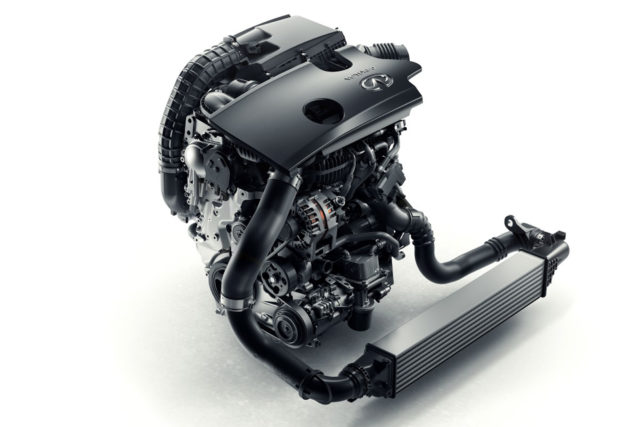 [1]
[1]INFINITI’s VC-Turbo engine is the world’s first production-ready variable compression ratio engine – and it makes its production debut on the new QX50. This unique variable compression technology represents a breakthrough in combustion engine design – the QX50’s 2.0-liter VC-Turbo continually transforms, adjusting its compression ratio to optimize power and fuel efficiency. It combines the power of a 2.0-liter turbocharged gasoline engine with the torque and efficiency of an advanced four-cylinder diesel engine.
As the luxury-vehicle arm of the Nissan Motor Corporation, Infiniti often serves as the research and development factory for the global company’s newest technology inventions. The company’s newest advancement with respect to the internal combustion engine, the 2.0-liter VC-Turbo engine, uses an industry-first variable compression arrangement to maximize performance and fuel economy. The design’s debut comes hot on the heels of Mazda’s Spark-Controlled Compression Ignition engine [2], and together, the two inventions could go a long way toward prolonging the use of the internal combustion engine, rather than hastening the seismic shift to electric powered-vehicles many have predicted.
Back in 2016, EngineLabs teased the invention [3], as Infiniti had released a few details on its design at that point. Just last week, more details were released, and according to the company, the variable compression engine is capable of transforming on demand to meet performance inputs from the driver.
In an interview with Automotive News [4], Shinichi Kiga, Nissan’s chief powertrain engineer, explained that Infiniti’s VC-T engine is expected to deliver a combined city-highway EPA-rated fuel economy gain of 27 percent over the QX50s’s outgoing 3.7-liter V-6. The VC-T engine is rated at 268 hp and 288 lb-ft of torque. He also says that the 2019 QX50 with the variable-compression 2.0-liter engine will reach 60 mph almost one second faster than its four-cylinder competitors.
So how does it work? Instead of using a single fixed connecting rod per cylinder as today’s internal combustion engines do, there are a pair of connecting rods for each cylinder. Well, sort of. The main connecting rod attaches to an elliptical-shaped device called the multilink, which is attached to the crankshaft where the big end of the rod would normally be fastened.
Then, on the other end of the multilink, there is another connecting rod with the small end fastened to the multilink, and its large end fastened to a shaft at the bottom of the crankcase. This shaft operates much like an electronically-controlled camshaft; using an actuator, the shaft can twist in one direction or the other, which causes the multilink to tilt up or down depending upon the command given, as you can see in the animation above.
When the multilink is tilted up, the engine produces 14.0:1 compression and runs in naturally-aspirated mode, and when it is tilted down, compression is reduced to 8.0:1 and the turbocharger comes online to boost power.
The engine makes use of all of today’s most advanced engine control systems, including a mixture of port and direct fuel injection along with variable camshaft timing. The VC-T design, which has been in the works for two decades, only became feasible in the last few years due to the advanced computer strategies required to intake the inputs from the variable valve timing system and fuel injection systems and output them properly to the multilink actuator system.
Kiga also shared that the variable-compression engine has less friction than other turbocharged four-cylinder engines despite having more moving pieces; the piston travels straight up and down in the cylinder, removing side-load issues that have been the source of heat creation. Infiniti plans to pair the variable compression engine with a continuously-variable transmission to help fuel efficiency.
Ultimately, the goal of the design is to allow the company to produce the power of a 2.0-liter turbocharged engine with the fuel efficiency and torque a 2.0-liter diesel engine is able to provide; the best of both worlds, so to speak. Although this engine in the QX50 may not turn out to be Infiniti’s sales leader, it will prove the viability of the technology in the hands of consumers. Will this technology ever come to the racing marketplace? There was a time we never thought electric vehicles would be there, but here we are…
